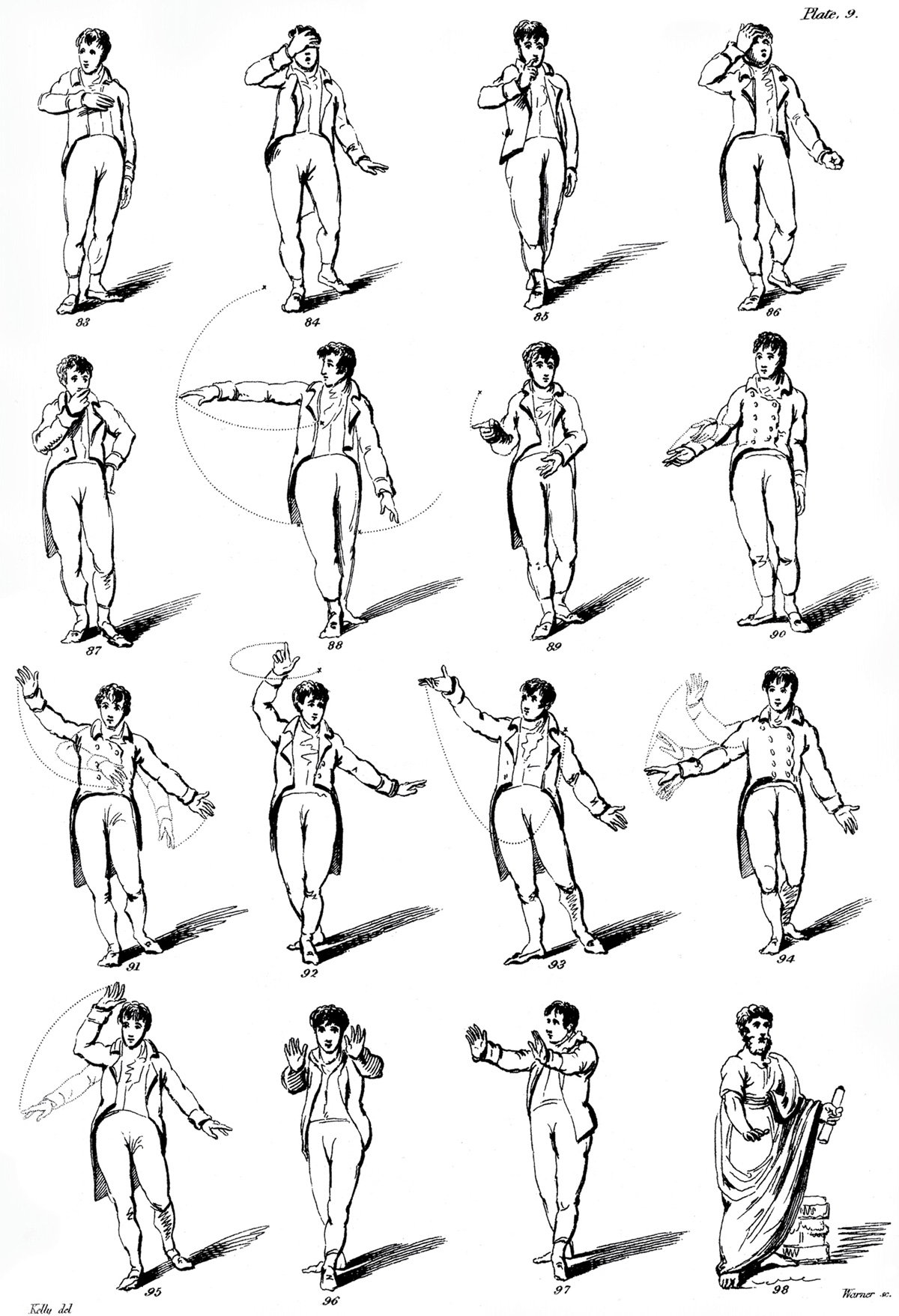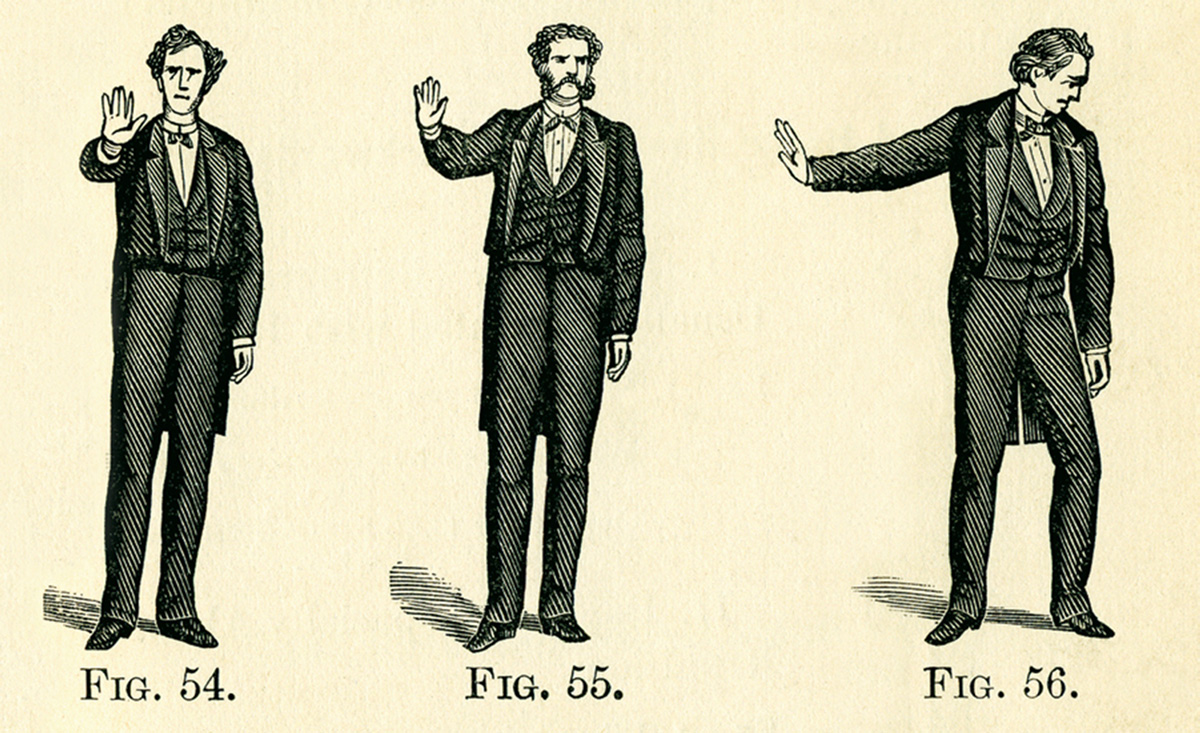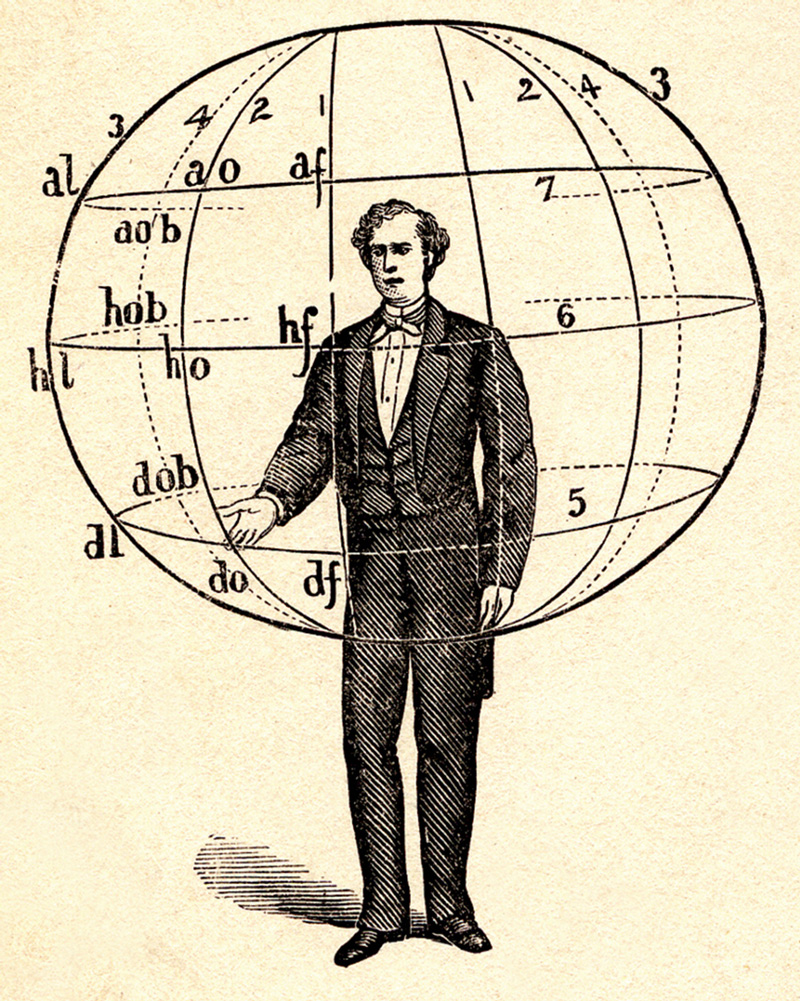Inventory / Talk to the Hand
Deciphering the language of gesture
Brian Dillon
“Inventory” is a column that examines or presents a list, catalogue, or register.
“By the end of the nineteenth century, the gestures of the Western bourgeoisie were irretrievably lost”: so writes Giorgio Agamben in his 1992 essay, “Notes on Gesture.”[1] The early years of the twentieth century were marked, the philosopher contends, by a frantic effort to reconstitute the vanished realm of meaningful movements: hence the exaggerated articulations of silent film and the mad leaps of modern dance. Certain “invisible powers”—the economic forces responsible for the simultaneous loosening and mechanization of the social sphere—had rendered daily life, for many, almost indecipherable. It’s a complaint that has echoed through the decades since, as subsequent generations have been characterized as increasingly shambling, ataxic, and slack, but also regimented, uniform, somehow less than human. The gestures of the (racial, national, or generational) other appear both random and programmed, meaningless and mechanical. Why, the gestural conservative wonders, do they keep doing that thing with their hands, arms, shoulders, crotches?
In truth, a generalized sense that something is awry in the world of gesture is considerably older than Agamben allows. Classical authors already fretted at the unruly manner in which public speakers utilized various parts of the body. As well as regretting the tendency to alter the tone of voice in a theatrical fashion, Aristotle disparaged the use of gesture. For Cicero, too, theater was the model of physical expression that was most tempting for, and most emphatically to be avoided by, the untutored orator. Rather, a measured and dignified movement was all that was required or allowed. In the first century CE, however, the Spanish rhetorician Quintilian elaborated what he called a “universal language of the hands”: a gestural tongue, as it were, that spoke also through the head, face, eyebrows, and even the nostrils. With the discovery of a manuscript of Quintilian’s Institutio oratoria in 1416, the modern era of movement studies began.
In the treatises and manuals that appeared in the centuries to follow, there is a growing sense that instruction in the proper use of gesture answers some widespread failing in public life. For a start, gesture seems a sort of anti-Babel, supplying meanings that language cannot: in Giovanni Bonifacio’s Art of Signs (1616), the whole body is employed to counter this tendency of the spoken word toward opacity. In their “mute expressiveness,” the head, face, arms, hands, fingers, nails, chest, abdomen, genitals, knees, and feet have all got something to say. In his Chirologia (1644) and Chironomia (1648), John Bulwer calls gesture “the only speech which is natural to man; it may well be called the tongue and general language of human nature which, without teaching, men in all regions of the habitable world do at the first sight most easily understand.” Bulwer, who also contrived a finger-spelling alphabet that he called “the deaf and dumb man’s friend,” claimed that his gesture manual had another application, being “so ordered to serve for privy ciphers for any secret information”: in the latter instance, he apparently forgot for a moment his own assertion of the universal legibility of gesture. Crucially, his volumes also include illustrations of the gestures he describes.
In the eighteenth century, the interest in gesture took a chauvinist turn. English writers on oratory, in particular, seemed proud of their nation’s public speakers but acknowledged at the same time that a more bodily effusive presence might raise the standard of public debate. “Our preachers stand stock still in the pulpit,” wrote Joseph Addison, “and will not so much as move a finger to set off the best sermons in the world. We meet with the same speaking statues at our bars, and in all the public places of debate. Our words flow from us in a smooth, continued stream, without those strainings of the voice, motions of the body, and majesty of the hand, which are so much celebrated in the orators of Greece and Rome.”[2] At the start of the nineteenth century, Addison’s observation had hardened into a received wisdom: the British (more especially the English) were ineloquent in the gestural department.
• • •
In the introduction to his Chironomia (1806), the most ambitious and influential study of gesture published in this period, Gilbert Austin notes: “It is not the genius of the people of Great Britain to gesticulate; they are grave people. To saw the air perpetually is absurd.”[3] (Austin was himself born in Dublin—he was a graduate of Trinity College and, as a Church of Ireland clergyman, a much admired preacher—but does not advert to any more daring or expansive gestures on the part of the Irish.) While the insular orator lacks the panache of his Continental coeval, he is not to be thought a mere dullard or plank: “Though in our temperate climate the people are less disposed to vivacity of manner, and are not easily excited; yet the cool, the solid and the cultivated understanding of the British speaker, under the direction of rational principles, is capable, as well in action as in composition, of all that is graceful and persuasive, and even of all the energetic and irresistible powers of delivery.”[4]

The full title of Austin’s book is Chironomia; or a Treatise on Rhetorical Delivery: Comprehending Many Precepts, Both Ancient and Modern, For the Proper Regulation of the Voice, the Countenance, and Gesture. Together With an Investigation of the Elements of Gesture, and a New Method for the Notation Thereof; Illustrated by Many Figures. It is in certain respects quite conventional, drawing upon classical sources to argue for a rational mean between expressiveness and restraint. As is usual by this time, Austin warns against the corrupting effects of bad theater—he exempts from censure the celebrated performances of David Garrick and Charles Kemble—and entreats his reader to maintain a degree of self-possession: “Where he is incapable of governing himself, he falls into undignified gesticulations, and into absurd distortions; and instead of inspiring others with his feelings, he will frequently become ridiculous, and be laughed at himself.”[5] It is in the second half of the book’s title that the real novelty of Austin’s project is revealed. He is exercised, he says, by “the want of a copious and simple language” to represent the many gestures that the orator may deploy. The prospective public speaker “sees few models which are worthy of imitation.” Chironomia is meant to “represent every action of an orator throughout his speech, or of an actor throughout the whole drama, and to record them for posterity, and for repetition and practice, as well as common language is recorded.” To this end, its author has recruited a Lilliputian army of exemplary orators; page after page of tiny figures that embody, by their numerous and subtly distinguished movements, the gamut of human gesture.
The figures are well-dressed and mostly male: in some instances they appear in classical costume, but they are in general, one may assume, diminutive gentlemen of the early nineteenth century. They have been trained, so to speak, in the opening pages of the book—put through their paces inside a sphere that illustrates the various quarters in which their gestures may be made. This space is divided first into zenith, horizon, and nadir; a more detailed mapping of movements is indicated by dotted lines that surround the speaker like a web. The whole apparatus is an invisible presence in all the images that follow; it provides the notional geometric arena in which gestures are to be described (in both senses of the word). Within their imaginary bubbles, Austin’s tiny avatars are to be seen looking quizzical, aggrieved, eager, despairing, emboldened, dismissive, and emphatic. In eight instances, they raise an arm and splay a flat hand to ward off some notional assailant or unconscionable idea.[6] Elsewhere, close-ups of sketched hands record the precise lineaments of waving, flourishing, sweeping, beckoning, repressing, advancing, springing, striving, recoiling, throwing, clinching, collecting, shaking, and pressing.
Given the precision of his spherical method, and the care with which each flourish of the hand or trajectory of the arm has been named and plotted, it comes as a surprise to find that Austin was less than sure of the efficacy of his book’s illustrations. He had intended, he tells the reader, a far more elaborate set of plates, but the initial drawings confirmed that the plan was ruinously expensive. Several times, Austin remarks upon the considerable labor and reflection to which his book has put him, as if aware that the move from illustrations of movement to annotated text—a necessary transition if the book is to be at all useful—is about to prove difficult for author and reader alike. A visual typology of gestures is all very well, but it does not exactly lend itself to easy marking-up of the orator’s text. Having drawn up the semaphore of possible gestures, Austin then needs to translate that language into a further set of ciphers that will sit legibly alongside the words to be spoken.
“It is necessary,” admits Austin at this point, “to give a short account of the difficulties which occurred in this system of notation of gesture, and of the manner in which they have been got over.” The problem, as he sees it, is that while the number of gestures is theoretically infinite, the range of symbols is, and must remain, limited. How then to render the stab of a finger, the attitude of an elbow, or the arc of a raised arm into a readable, and repeatable, code? The introduction of new names for the gestures in question, Austin concludes, is likely to prove “embarrassing” and “offensive”: he does not say whether the objections would be directed at the awkwardness of the lexicon or at an overly intimate attention to the outline of the body beneath the tailcoat and breeches. In any event, he decides instead on a system of symbolic letters: they will simply be easier to recall. In this last assertion, he was spectacularly mistaken.
The actual workings of Austin’s system of annotation are horrifically complex, so much so that the editors of the 1966 edition of his book sincerely doubt that any prospective public speaker could marshal the necessary information and acquire the proper skills to follow it. Each movement of the hand is denoted by four letters: they mark in turn the position of the hand, the elevation of the arm, the transverse situation of the arm, and the motion or force of the gesture. Thus, phfd means prone horizontal forward descending; seqn signals supine elevated oblique noting. Often, the last letter is omitted, but a further three letters then added for the left hand: phq—pdb, then, according to a complex table to which the orator would first have to refer (having already appraised himself of the names of the various movements depicted in the illustrations), means prone horizontal oblique—prone downwards backwards. At this point, things become more complex: a capital letter at the start of a sentence fixes the position of the head and the direction of the gaze; another set of symbols, below the line of spoken text, instructs the orator where to place his feet; a marginal mark suggests the force, rapidity, or interruption of the voice. To attempt to follow one of Austin’s annotated extracts from canonical texts—Thomas Gray’s “Elegy Written in a Country Church Yard,” Edward Young’s “Night Thoughts,” a speech of Brutus’s from Julius Caesar—is to become, inevitably, a clumsily articulated automaton, a mechanized monster of crippling self-consciousness. The gesticulating figures, with their elegantly executed actions, are overacting energetically to hide the degree of confusion and exhaustion that awaits any reader rash enough to put the system to the test.
Despite its rigors, however, Chironomia was remarkably influential among later authors of Victorian gesture manuals. It is the model for several volumes published in the United States in subsequent decades. Dr. Jonathan Barber went so far as to construct a bamboo replica of Austin’s sphere, which he used to teach students at Harvard and recommended in his 1831 Practical Treatise on Gesture. The average American orator, it seems, presented the opposite problem to his British counterpart. As A. M. Bacon avers in his Manual of Gesture of 1875, the native public speaker is grievously in need of the prince’s counsel to the players in Act III, Scene ii of Hamlet: “In the very torrent, tempest, and, as I may say, whirlwind of your passion, you must acquire and beget a temperance that may give it smoothness.”[7] Drawing explicitly on Austin’s system, Bacon merely simplifies it somewhat and updates the attire of his illustrative figures, so that they appear less flamboyantly dressed, sober-suited, and stately. (Also, sporting a modish variety of facial hair.)


Introducing Chironomia in 1966, Mary Margaret Robb and Lester Thonssen comment that, in discovering a method for recording the gestures of great orators, Austin “anticipated the electronic wizardry of tape and disc.” Oddly, the editors do not mention cinema, which is surely the closest analogue to the illustrations in Chironomia. Like the motion studies of Eadweard Muybridge, the frozen gestures of 1806 almost demand to be set in motion, to be stitched together in a flicker-book approximation of the cinematographic technology to come. As with cinema, the paradox at the heart of Austin’s system is that in order to describe (never mind begin to prescribe) bodily movement, one has first to decompose it into its constituent parts. The mobile orator actually has to become one of Addison’s “speaking statues” before being allowed to breathe, move, and live once more. In this sense, Chironomia is but the first step in a vast project undertaken by the arts and sciences in the nineteenth century: the isolation of the instant so that physical expression may be pictured, comprehended, and archived before it passes away. It is the ambition, for example, of Charles Darwin’s The Expression of the Emotions in Man and Animals (1872), with its photographic register of grinning and gurning faces. It is the impulse behind Jean-Martin Charcot’s record of the unruly but typical gestures of the hysteric. The photographs taken at the Salpêtrière clinic are now better known than the tabulated drawings produced by Charcot’s colleague Paul Richer, whose “complete and regular form of the great hysterical attack,” rendered in eighty-six disheveled female figures, resembles nothing so much as Austin’s anatomizing of the rhetorical gestures of the erudite gentleman. The orator, like the hysteric, is the anxious object of an abstracting gaze, made to perform his every natural affect and impulse according to a predetermined plot. At times, you can almost imagine that he revolts against this inhuman regimen, that he is madly signaling for assistance, or raises his arm at a random and rebellious angle, letting it drift along a dotted line of his own choosing, through the air’s uncharted ways.
- Giorgio Agamben, “Notes on Gesture,” in Infancy and History: Essays on the Destruction of Experience, trans. Liz Heron (London: Verso, 1993), p. 135.
- Joseph Addison, The Spectator, no. 407, 17 June 1712.
- Gilbert Austin, Chironomia: or a Treatise on Rhetorical Delivery, ed. Mary Margaret Robb and Lester Thonssen (Carbondale: Southern Illinois University Press, 1966), p. 134. Austin, it seems, may not have read Bulwer’s Chironomia, but arrived at the same title by reference to sundry classical sources.
- Ibid., p. xi.
- Ibid., p. 138.
- This venerable gesture, which we may assume was a staple of nineteenth-century stage melodrama, was preserved and perfected in silent film, then abandoned with the advent of cinematic sound, and relegated to the practical repertoire of the traffic cop. It was only in the televised performances of the girl groups of the 1960s that it found its proper emotional valence again. In particular, the Supremes’ 1965 entreaty to “Stop! In the Name of Love” would have meant nothing without this gesture. Nowadays, it has only an ungracious and anomic significance, as the (somewhat dated) title of this essay confirms.
- A. M. Bacon, Manual of Gesture (Chicago: S. C. Griggs, 1875).
Brian Dillon is UK editor of Cabinet, and writes regularly for Frieze, Modern Painters, and Art Review. His memoir In the Dark Room (Penguin, 2006) won the inaugural Irish Book Awards non-fiction prize. He is working on Tormented Hope: Nine Hypochondriac Lives, to be published in 2008.
Spotted an error? Email us at corrections at cabinetmagazine dot org.
If you’ve enjoyed the free articles that we offer on our site, please consider subscribing to our nonprofit magazine. You get twelve online issues and unlimited access to all our archives.